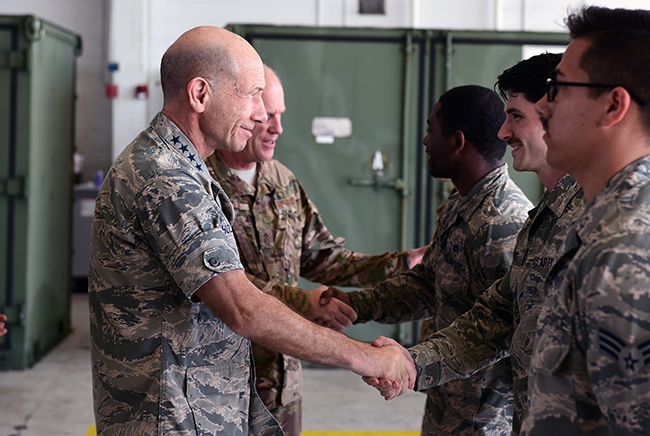
Air Combat Command boss Gen. Mike Holmes, left, commends airmen while at Tyndall AFB, Fla., on Nov. 7, 2018. Air Force photo by SrA. Isaiah Soliz.
Air Combat Command boss Gen. Mike Holmes recently called on the Air Force’s weather forecasters for a long-term look at how its assets could fare against climate change threats.
Airmen with the 14th Weather Squadron produced a weather and climate threat assessment that covered a 50-mile radius around ACC’s main operating bases as well as two others where ACC maintains a significant presence, said Ryan Hansen, a spokesman for the 55th Wing at Offutt AFB, Neb.
“Subject matter experts from the 14th WS mined authoritative datasets to determine the prevalence of impactful weather conditions,” Hansen said. “Assessed phenomena included extreme temperatures, droughts, high winds, floods, wildfires, severe weather, and instrument flight rule conditions.”
Forecasters also predicted how those threats could change over time, Hansen said. Their data can help the Air Force invest in strategies to protect itself from strong storms like Category 5 Hurricane Michael that devastated Tyndall AFB, Fla. last fall, and that contributed to a historic flood at Offutt this spring, as well as from other effects of climate change.
“Without getting into a political argument about when and why, we know that sea level is rising, at least for now, around the world,” Holmes told reporters at an Air Force conference in Dayton, Ohio, in June. “I wanted to have them give me at least some kind of forecast of what’s going to happen so we can figure that into the investments that we make.”
Holmes wouldn’t divulge information about specific bases, and noted that the study hasn’t “really had any impact so far on what we do.”
“I felt like it needed to be part of the puzzle, that as we look at the Air Force we need, as we think about our long-term basing, part of where the basing should be, is whether it will be underwater 50 years from now or not,” he said.
He noted forecasters looked at places where altitude and temperature drive aircraft performance problems, areas that are prone to extreme tornadoes and tropical storms, and more.
“After Tyndall, I had people write me notes and say, ‘You know, this is why you should never have anything in a hurricane, you should move everything inland,” Holmes said. “I see your point, but with a hurricane, I get 72 hours’ notice. With the tornadic activity at Offutt or Tinker, I might get a few hours notice.”
Moving assets to the West Coast would place them in the way of wildfires, he continued: “There are trade-offs—there’s no one place that would be the magic answer.” Forces have to be spread out around the country to effectively defend the homeland and to ensure aircraft remain if some are damaged in one part of the country, Holmes added.
In June, ACC said it plans to release the findings of a severe weather readiness action team that analyzed four case studies in order to support commanders during the 2019 hurricane season and installations near the Atlantic and Gulf coasts. The command also expected to put out readiness guidance to all wings, numbered Air Forces, and direct reporting units in “high-risk areas” of the US.
“The assessment provided opportunities for ACC to rethink how we view readiness when it comes to weather,” a command spokeswoman told Air Force Magazine in July. “Hurricane Ready (HUR-RY) Prep was created to be implemented prior to hurricane season when severe weather is more likely to occur. HUR-RY Prep focused on recommendation for exercises and training, facility inspection and sheltering plans, installation environment inspections/preparation, equipment readiness checks/testing, identifying response/recovery teams, equipment and supplies, protection of key support equipment and preparation and hardening of the emergency and crisis action facilities.”
